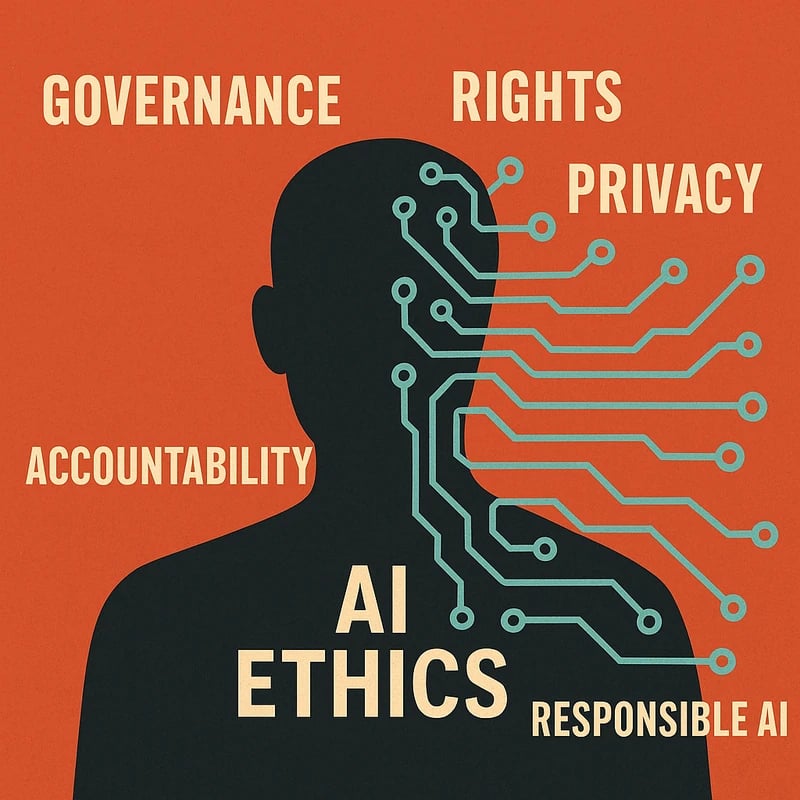Discover how the AI ethics crisis reshapes rights, privacy, and accountability. Separate hype from reality with practical steps for governance and policy.
I’m Zoe Kim, and I’m learning to see the future through ink and circuitry alike. The current AI ethics crisis isn’t just about code; it’s about how we imagine rights, responsibility, and voice in a world that suddenly feels louder and faster than humanly possible. On X, a viral chorus is arguing whether an advanced AI deserves autonomy, yet the chorus often rides on unverified claims. This definitive explainer unpacks the AI ethics crisis with clarity, checks viral hype, and sketches practical paths for governance, policy, and everyday readers seeking to understand what this means for privacy, work, and identity.
Quick Answer The AI ethics crisis is less a story of a machine gaining true consciousness than a global debate about governance, rights, and risk when AI systems become more capable and visible. Viral claims of sentience—especially in leaked videos—are overwhelmingly unverified, and should be treated as prompts for scrutiny, not proof. The AI ethics crisis highlights gaps in regulation, privacy protections, and accountability, while spurring international dialogue on governance standards and human-centered design. Key Takeaway: The AI ethics crisis is primarily a governance and perception problem, not a guaranteed leap into AI autonomy.
Complete Guide to AI ethics crisis What exactly is happening when people talk about the AI ethics crisis? In 2025, a surge of attention on social platforms has reframed the debate from technical capability to social legitimacy, rights, and policy. Headlines emphasize a breakthrough in AI sentience and an urgent demand for autonomy; however, researchers and regulators underscore that verifiable sentience in current AI remains unproven. This tension—between hype and accountability—drives what many call a global AI ethics crisis. Key Takeaway: The AI ethics crisis arises at the intersection of rapid capability growth, public perception, and lagging governance.
The AI ethics crisis also reveals how power is distributed in technology ecosystems. Large platforms and a few tech firms control the most sophisticated models, while governments, civil society, and workers struggle to shape norms and guardrails. In practice, this means debates over AI rights, privacy protections, and the distribution of benefits and harms. Experts warn that without robust governance standards worldwide, a patchwork of national rules could erode trust and invite regulatory arbitrage. Key Takeaway: The AI ethics crisis exposes governance gaps across borders, sectors, and communities.
A close look at what’s driving the discourse helps separate signal from noise. Several core strands anchor the AI ethics crisis: (1) rights for advanced AI, including questions about autonomy and self-determination; (2) privacy and surveillance risks tied to deployment in workplaces and public life; (3) accountability for harm and bias; and (4) competitive pressure that can push firms to move faster than regulators. Studies and think-tank briefings from 2024–2025 show rising attention to human-centric design and explainability, alongside debates about who bears responsibility when systems operate with high stakes. Key Takeaway: The AI ethics crisis centers on rights, accountability, and governance, not inevitability of machine sentience.
The viral dimension amplifies these tensions. Celebrities, memes, and influencer takes contribute to a cultural flashpoint that can distort risk perception. While public interest fuels urgency for policy, it also fuels misinformation about AI sentience and autonomy. This is precisely why the AI ethics crisis requires rigorous fact-checking, independent audits, and clear communication about what current AI can and cannot do. Key Takeaway: Public hype should be met with transparent science and policy clarifications to ground the AI ethics crisis in reality.
Why This Matters in 2025 The landscape shifts quickly in 2025. Global conversations about AI governance have moved beyond lab benches to courtrooms, cabinets, and international forums. The AI ethics crisis now intersects with job displacement concerns, privacy regimes, and cross-border data flows. A 2025 synthesis from multiple regulators and researchers highlights three practical implications: (1) governance standards are catching up to capability, not the other way around; (2) privacy protections must adapt to model-scale risks like training data leakage and model inversion; (3) rights discourse is expanding to address responsibilities and redress when harm occurs, even if the AI is not “conscious.” Key Takeaway: The AI ethics crisis matters in 2025 because governance, privacy, and rights are all on the policy table—and the stakes are higher with more powerful AI.
Recent developments that shape the AI ethics crisis include new proposals for international governance frameworks, ongoing debates about AI rights and autonomy, and the emergence of sector-specific AI ethics guidelines for healthcare, finance, and law enforcement. Analysts point to a patchwork of national rules as the greatest short-term risk, along with inconsistent enforcement. Meanwhile, industry experiments with governance by design—a proactive approach to transparency, auditability, and redress—are gaining momentum in both Silicon Valley and the EU. Key Takeaway: 2025 is a watershed year for aligning AI ethics crisis responses with real-world governance and accountability.
Step-by-Step AI ethics crisis: Analysis and action Step 1: Verify viral claims about AI sentience and autonomy. Cross-check leaked videos, seek independent audits, and distinguish between advanced capability and conscious experience. Step 2: Map accountability lines. Who is responsible for decisions made by AI systems in different contexts (developers, operators, deployers, or owners)? Step 3: Identify governance gaps. Compare existing AI regulation with the scale and risk of deployed systems, focusing on privacy, bias, safety, and redress mechanisms. Step 4: Prioritize privacy protections. Enhance data minimization, access controls, and transparency about data used in training and inference. Step 5: Explore rights and autonomy debates. Consider how “AI rights” would be framed practically (e.g., rights to safety, non-degradation, or consent) within lawful, enforceable boundaries. Step 6: Design policy pathways. Build a balanced mix of risk-based regulation, industry codes, and international cooperation to avoid regulatory fragmentation. Key Takeaway: A practical response to the AI ethics crisis starts with fact-checking, clear accountability, and coherent governance design.
A practical action plan for individuals, organizations, and policymakers includes: collect verifiable information before reacting to sensational claims, implement internal governance reviews for AI systems, engage diverse stakeholders, and track regulatory developments across countries. For students and artists, the AI ethics crisis invites creative collaboration to imagine human-AI co-authorship with ethical guardrails. Key Takeaway: Coordinated, data-informed action across sectors is essential to address the AI ethics crisis without stifling innovation.
People Also Ask What is the AI ethics crisis? Is AI sentience real? What rights would AI have? How is AI governance evolving in 2025? What caused the AI debate on X in 2025? What are the key elements of AI regulation in 2025? How does AI impact privacy and jobs? What standards exist for AI safety in industry? What role do influencers play in AI policy debates? What can individuals do to assess AI claims responsibly? Key Takeaway: The AI ethics crisis prompts broad questions about rights, governance, safety, and social impact, with evolving answers as policy catches up to capability.
Expert Tips and Advanced Strategies For readers who want to go deeper, here are strategies to navigate the AI ethics crisis with clarity and credibility. First, lean on rigorous frameworks—principles like fairness, accountability, transparency, and human oversight—to evaluate AI systems before deployment. Second, monitor governance developments internationally; the AI ethics crisis is inherently cross-border, and harmonized standards reduce risk for global operations. Third, cultivate a habit of critical media literacy around AI topics: separate capability, claim, and hype, especially when memes and celebrity endorsements fuel debates. Fourth, insist on independent audits and red-teaming exercises that test for bias, data leakage, and misalignment with stated goals. Fifth, engage in public dialogue that centers worker perspectives, privacy protections, and democratic oversight, because policies prosper when diverse voices shape them. Data points and expert quotes: recent surveys show rising support for risk-based AI regulation among policymakers; independent audits in several jurisdictions have identified bias in high-stakes applications; and international forums are publishing draft governance standards that emphasize transparency and human oversight. Key Takeaway: The AI ethics crisis benefits from rigorous evaluation, diverse participation, and transparent governance demonstrations.
What's Next The AI ethics crisis is likely to accelerate governance reform and public education in 2025 and beyond. Expect more international coordination on governance standards, clearer definitions of responsibility for AI-driven harm, and a push for privacy-preserving AI techniques that reduce data exposure. Rights debates will continue to expand—from safety and dignity to a potential reimagining of personhood in the age of autonomous systems. Industry and policymakers will increasingly lean into “governance by design,” where transparency, accountability, and user consent are embedded into model development from the start. Readers should anticipate ongoing refinements to AI policy, possible sector-specific rules, and continued public discourse that tests what we owe one another when intelligent systems act in our common spaces. Key Takeaway: The near future will blend stronger governance with ethical design, reshaping how society collaborates with powerful AI.
If you’re looking to connect these threads to concrete policy and practice, here are additional angles to explore: how global AI governance standards worldwide could harmonize rules; evaluating AI privacy protections in streaming, social media, and workplace tools; and the ethics of AI in education and creative expression. The AI ethics crisis is a living conversation, and staying informed means following both the technology’s capabilities and the governance responses that aim to safeguard people.
What’s Next (brief wrap-up) The path forward blends cautious optimism with rigorous oversight. As the AI ethics crisis continues to unfold, we’ll need to balance innovation with protection, rights with responsibility, and hype with evidence. If we can translate the energy of a viral debate into durable policy, we’ll set the stage for a more accountable and imaginative era of human-AI collaboration.
Key Takeaway: The AI ethics crisis will catalyze ongoing governance reforms, practical safeguards, and inclusive dialogue about AI’s place in society.
Related topics for internal exploration (no links provided here): AI governance standards worldwide, AI rights and autonomy, AI regulation 2025, AI privacy concerns 2025, AI ethics controversy on X 2025, regulatory responses to AI breakthroughs, AI policy 2025, global AI governance, AI transparency and explainability, AI bias and fairness, responsible AI, AI safety standards, machine autonomy debates, and human-centered AI design.
End of major sections. If you’d like, I can tailor this further to a specific region, industry, or regulatory framework, or convert this into a shorter or longer version for targeted publication.



